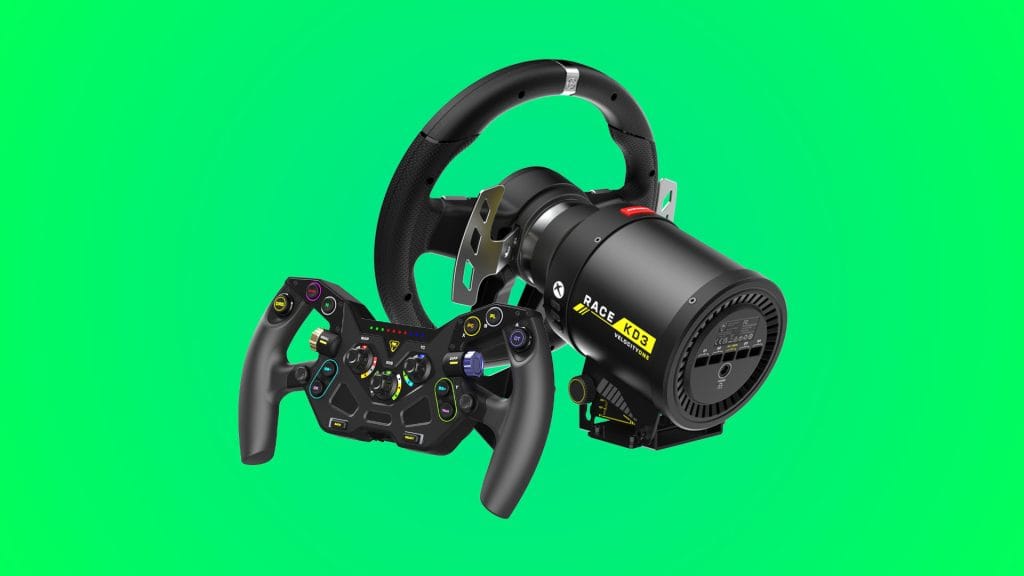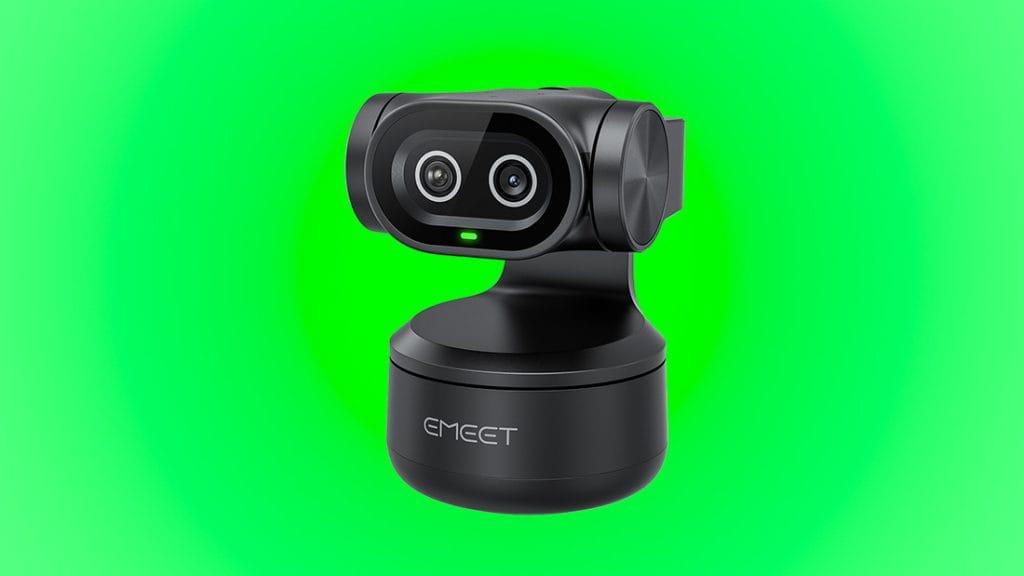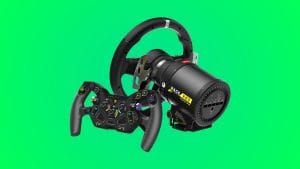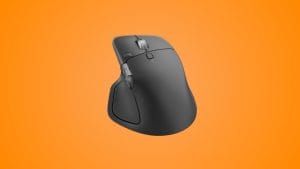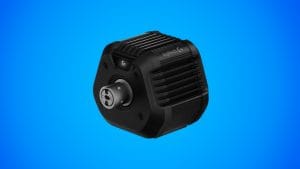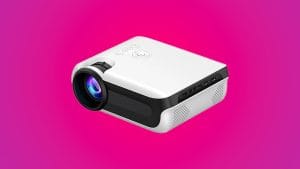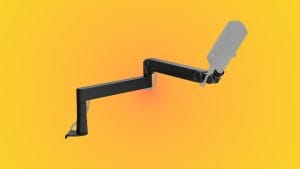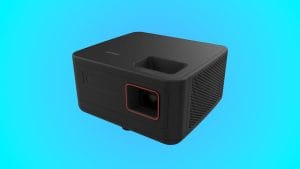EMEET Pixy Dual-Camera AI PTZ 4K Webcam
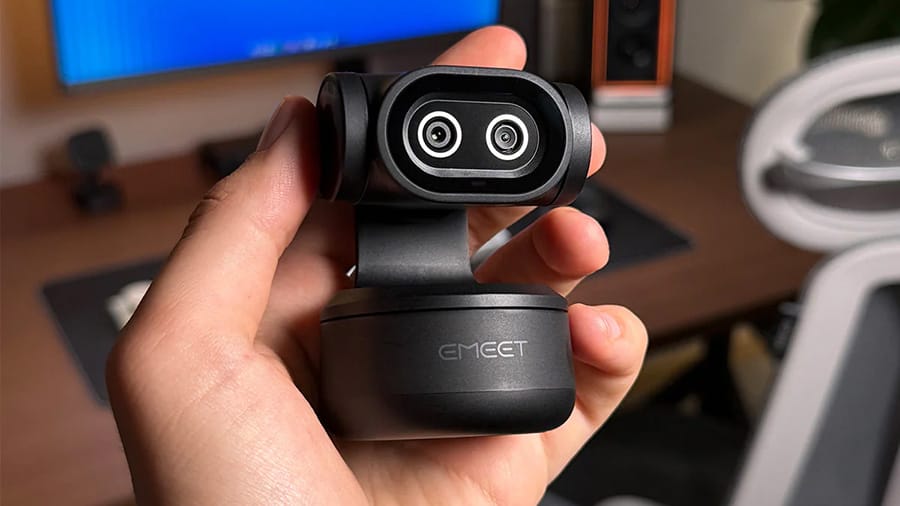
design
The EMEET Pixy isn’t your standard looking webcam. If Disney did webcams it would probably look something like this and it’d have a sassy personality to boot. The Pixy has a rounded, weighty base with a gimbal-mounted camera floating above on a rear arm. It’s strangely charming and hugely personified, the dual lenses looking like eyes in a sci-fi helmet just politely looking at you from across the desk.
All of that is pretty standard for this new style of PTZ webcam, where things get different with the EMEET Pixy is what’s going on inside that little visor. Rather than one sensor, you’re looking at two 12MP Sony sensors side by side. Only one actually captures video though – the other exists purely to feed data for better autofocus and tracking. It’s a clever idea in theory, though I’ll admit I couldn’t definitively tell you how much difference it makes compared to single-sensor competitors. At the very least it looks cool as a set of eyes so I’m on board.
The EMEET Pixy will sit flat and stable on a level surface, there’s a standard thread underneath for attaching to tripods or arms, and a detachable screen mount too. It’s this mount I assume most people will use and I found it hangs onto the top of your monitor securely enough, though I did find the whole setup sits quite high and feels a bit top-heavy as a result. If you’ve got a particularly thin monitor you might want to investigate a different mounting solution.
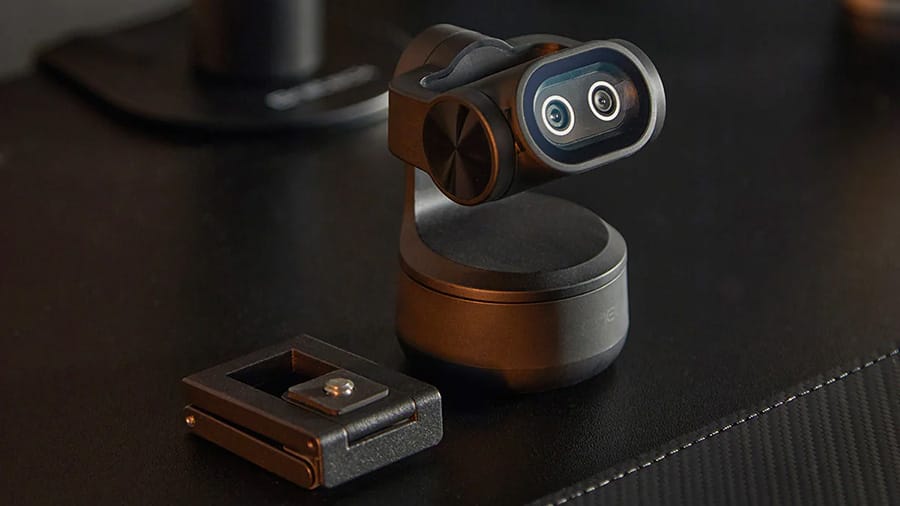
Connectivity is straightforward with USB-C, though it only actually needs USB 2.0 bandwidth so you can use the included USB-A adapter or BYO cable without losing anything. Setup is genuinely plug-and-play – no drivers needed, though you’ll want to grab the EMEET Studio software to access all the features. I’ve had a number of firmware updates in my time testing it and these do generally seem to make things better rather than worse, though I had plenty of frustrating failed firmware updates along the way.
performance
Extra features are great but ultimately it’s image quality that’s most important for a webcam and the Pixy is more than solid for the price in the right situations. The simple version is the 4K sensor is capable of producing impressive visuals with good detail and decent colours, with plenty of light to play with I was pleased with what I saw. At fully default settings I found the EMEET Pixy to be an improvement over the Elgato Facecam MK2 and just shy of the Razer Kiyo Pro Ultra, this one was close however. I didn’t feel the need to dive deeper and mess around with manual settings, though there are all the usual sliders in the EMEET Studio app, along with a few one-click presets too.
For productivity and general video calls, the EMEET Pixy is a great option that’ll likely deliver the best quality of any camera on your call. In full daylight situations it was noticeably clear, while the auto focus did a great job of continually keeping me sharp while I moved around. Things weren’t quite as good as I approached the end of the day however, as the sun faded in my office so did the camera quality and while it never reached a stage of being bad, there was obvious noise and an overall softness that crept in without loads of light hitting that sensor.
For streaming and content creation I was also impressed with what the EMEET Pixy had to offer though it’s important to keep expectations in check here. With my Elgato Key Light Airs blasting into my face I looked great and the Pixy was able to capture plenty of saturated colour from the Nanoleaf Lines on the wall behind me. There was a small amount of depth and separation, but if you’re looking to the EMEET Pixy as a DSLR-like alternative you’ll be underwhelmed in this area. Specific lighting is critical for success, you won’t see strong results with just a ceiling room light, you’ll need to invest in something dedicated.
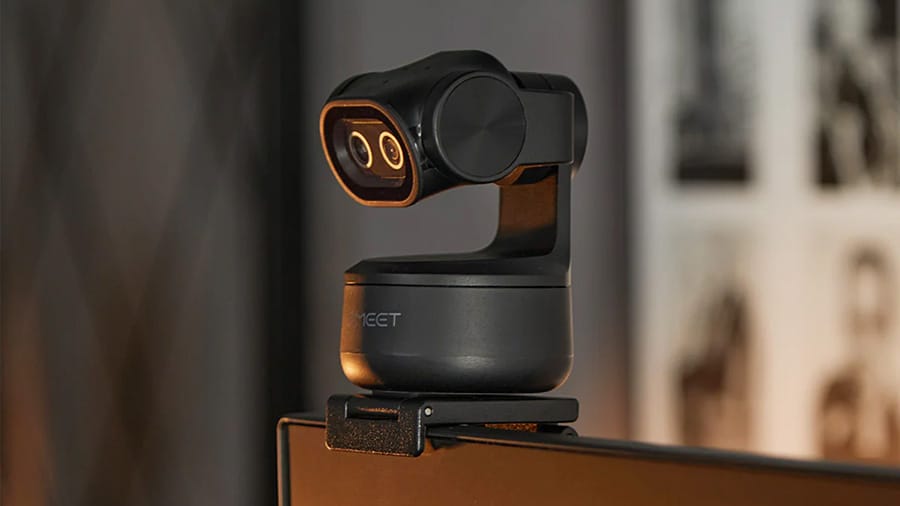
If you’re just after quality visuals though you likely wouldn’t be looking at a PTZ-style webcam. It’s the EMEET Pixy’s gimbal movement and AI-powered tracking that will be the drawcard for most. The good news is it works wonderfully well and is unbelievably cool when it’s behaving itself. The bad news is it’s prone to not behaving itself and packing up entirely. Throughout testing there were multiple times I needed to disconnect and reconnect the camera in order to get it to play nice, in some cases it needed a full PC restart too – not ideal.
The range of motion on offer is good with a couple of ways to move the EMEET Pixy’s little robot head. You can manually control it like an old school security camera using the app, or have it automatically track your face. The latter is really rather cool I have to admit, though in the wrong situation it can end up being a tad distracting for anyone on the other end of your feed. I turned the feature off for work video calls because the constant small adjustments were both unnecessary and drew attention to me when it didn’t need to be. For streaming where I’m the main event however it was a nice added focus. I used the EMEET Pixy when streaming from my Playseat Trophy playing F1 25 and it handled the distraction of my hands on the wheel particularly well and kept my face in frame nicely.
There’s a couple of extra feature modes like a whiteboard presentation that adjusts and focuses on boards you’re showing off, these work alright and could be useful for some though they do feel a tad gimmicky. More useful is the privacy mode that sees the EMEET Pixy turn to face the floor when not in use. It’s a clever take on the privacy cover and I enjoyed the fact this happened automatically, though I did notice a couple of times where the camera was supposed to be off but was still pointing straight ahead so the feature may need some tightening up with future software updates.
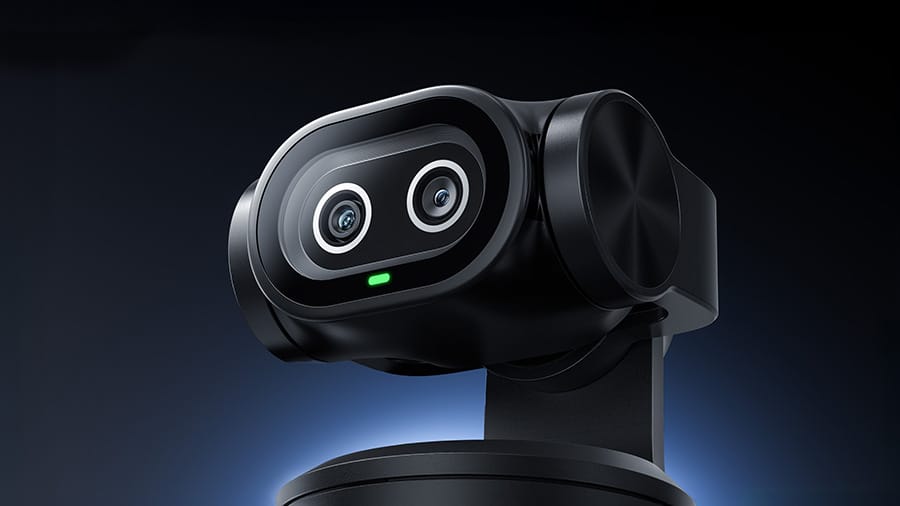
Here’s where we need to talk about the software though, because it’s where things start to unravel a bit and where you’re quickly reminded you’ve strayed from the major brand path. EMEET Studio offers a lot of functionality – maybe too much, honestly. The interface feels cluttered and navigation isn’t always intuitive as a result. During my testing I experienced stutters, freezes, and even a handful of crashes. Nothing catastrophic, but enough to be frustrating. The software and firmware update process is particularly painful. Constant aggressive notifications badger you to update, but then the updates themselves frequently fail even when you’ve closed everything that could possibly be using the webcam. I had to attempt several firmware updates multiple times each before they’d stick.
Built into the Pixy is a triple-array microphone setup, which on paper should be better than most webcam mics. In practice it’s actually pretty decent, certainly good enough for video calls without needing a separate microphone, though I wouldn’t rely on it for anything more serious than that. There are different recording modes to adjust noise cancellation based on your environment, which is a nice touch.
summed up
The EMEET Pixy is equal parts impressive, gimmicky, and frustrating – it’s an interesting balance of flavours. At a base level though it offers impressive hardware at a genuinely competitive price. The dual-camera system is a novel approach even if I’m not convinced it’s dramatically better than single-sensor competitors, and the build quality feels premium. Image quality is solid, the gimbal tracking works well, and the microphones are better than expected for a webcam.
At $159/£146, it undercuts most premium webcams while still delivering 4K, AI tracking, and a decent feature set. If you’re after those capabilities without breaking the bank, the EMEET Pixy makes a compelling case on paper. The problem is everything surrounding that hardware. The software is buggy and crashes too often, firmware updates are a frustrating lottery, and the interface feels like it’s trying to do too much without doing any of it particularly well. These are issues that could potentially improve over time, but I can only speak to how it is now, not what it might become.

